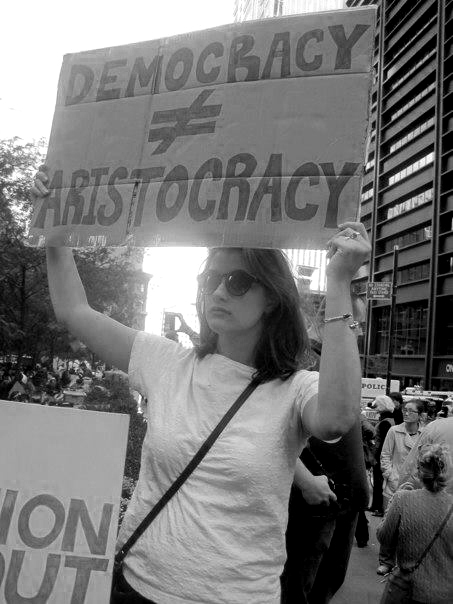
Eliza Bryant '12 protesting in New York.
Editor’s note: This is the first of many in a series covering the Occupy Wall Street protests that Megan Reback will be writing in the following weeks.
After several meetings, dozens of conversations, and hours of organizing, twenty Connecticut College students travelled to New York City this past weekend to Occupy Wall Street.
But last Friday, their day of departure, the group realized that their plans would be disrupted. Mayor Bloomberg had announced that Zuccotti Park in Lower Manhattan, where protestors have been camping out for almost a month, needed to be cleaned, and that the park would be vacated. Members of Occupy Wall Street called the move by the Mayor “an eviction notice.”
However, in what appears to be Bloomberg’s increasingly accepting attitude toward the protests, he announced that cleaning the park would be postponed, averting yet another confrontation between the NYPD and protesters. Instead, the protesters formed cleanup crews, gathered cleaning supplies, and cleaned the park themselves.
While Zuccotti Park has acted as a home base of sorts for the protestors, lately their presence has grown more visible throughout the streets of New York City. This past Saturday, Connecticut College students participated in a march from Lower Manhattan to Times Square with an estimated 5,000 other protesters. Senior Javier Mijares said that the march to Times Square had “lots of energy, lots of arrests, and lots of police brutality,” despite the fact that protesters demonstrated peacefully. According to the New York Police Department, there were 74 arrests in total on Saturday.
In an e-mail correspondence live from Times Square on Saturday, Senior Eliza Bryant said she and other protesters participated in a drum circle, chanting “all day all week, Occupy Wall Street,” and sang ‘This Land is Your Land,” “If I Had a Hammer,” and “Solidarity Forever.”
That evening, the protesters held a general assembly. Some organizers proposed occupying Washington Square Park as way of expanding the movement’s resource base from Zuccotti Park. Bryant described the system that protesters used to communicate and make decisions:
“In order to discuss this proposal we broke into small groups … and used a facilitator in each group to get our ideas around … Without a sound system, we used a system of communication in which the person speaking yelled to the crowd in snippets and after each snippet everyone who could hear would repeat it and then those who could hear the repeat would repeat that so even the people on the outskirts of the crowd got to participate in the conversation. For an hour and a half we discussed the pros and cons of occupying Washington Square park after closing (which would mean we would be arrestable) and in the end decided that it would be more strategic to wait and find a smaller, more manageable and less provocative park for us to use as an expansion of Zuccotti … Nearly everyone who got on the speaking list (priority was given to those who have traditionally been oppressed in our society- women, minorities etc.) had something valuable to say and nearly everyone respected the system by being quiet when they were supposed to be.”
Protesters also used a system of hand signals called “temperature check” to gauge the crowd’s response to ideas for occupation.
The Occupy Wall Street movement, which started in mid-September of this year, was envisioned by the Canadian-based group Adbusters Media Foundation who proposed a peaceful occupation of Wall Street to protest the impact of corporations on democracy. Adbusters has said that one of the central demands of the protest is that President Obama “ordain a Presidential Commission tasked with ending the influence money has over our representatives in Washington.”
The movement’s official website describes “the one thing we all have in common is that We Are the 99% that will no longer tolerate the greed and corruption of the 1%. We are using the revolutionary Arab Spring tactic to achieve our ends and encourage the use of nonviolence to maximize the safety of all participants.”
Activists from the group Anonymous, salon.com blogger Glenn Greenwald, filmmaker and social critic Michael Moore, and civil rights activist Cornell West, among others have backed the protests.
While the movement has been criticized for its lack of apparent goals and cohesion, Greenwald has responded: “Does anyone really not know what the basic message is of this protest: that Wall Street is oozing corruption and criminality and its unrestrained political power – in the form of crony capitalism and ownership of political institutions – is destroying financial security for everyone else?”
The media has focused less attention on the actual demands of the movement, and more on the confluence of police brutality, which was rife during the third week of protests. Police have used pepper spray, batons, and reportedly mowed down protesters with motorcycles in an attempt to clear the streets and control the masses of people.
In response to this tactic by police, Bryant said that protesters are committed to peaceful protest, but said, “I was definitely very afraid of the possibility of police brutality.”
Yet protesters are seemingly willing to endure arrest and brutality in order to achieve their goal, which is evidenced by the sheer number of people participating in New York, throughout the United States and around the world. Indeed, on the same Saturday that twenty Connecticut College traveled to New York City, protests were held in dozens of U.S. cities in every state, including Washington, Boston, Chicago, Los Angeles, Charlotte, and Miami. Protests spanned from Asia to Europe amid a widespread global economic crisis. Cities including Madrid, London, Sydney, and Rome participated, with protests in Rome growing violent.








